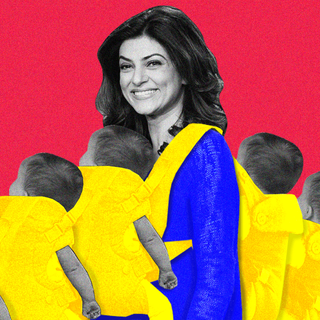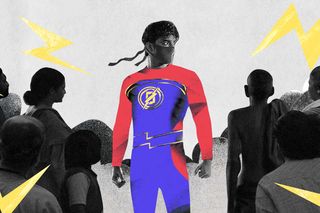
‘Minnal Murali’ Subverts the Superhero Genre Through the Supersuit
The cape of this Indian superhero represents accountability and access to the community he comes from.

The superhero myth has circled the world and successfully docked at the coast of Kerala in the form of Minnal Murali (2021). This is of course not the first time India has seen its own superheroes. Take for instance the uncompromisingly derivative Krrish, the Superman sequel to Hindi E.T. produced by Bollywood in 2006.
However, Minnal or Lightning Murali’s Malayalee colloquialisms transform our notion of what a superhero film should look like. This is a world that is both absurd but confined to realism; simple, but where complex emotions are exteriorized. Jaison, the superhero’s Peter Parker alias, is a tailor who dreams of going to America.
He thinks that knock-offs are the real deal and sticks out in his ABIBAS and POMA sweatshirts smack in the middle of rural Kerala. He sports a dangling cross earring, something you might see on a member of the Korean pop band BTS. The belted trousers Jaison dons possess a silly, spinning buckle. Minnal Murali feels homemade, a quality most visible in his super suit. It localizes him, rather than distances him from the people he is trying to save.
The super-suit, writer Michael Chabon says in his essay “Secret Skin,” is an illusion. This is one reason that cosplay may never match up to the icons it emulates. Anything recognizably human – specks of dust, fading color, loose threads, visible panty lines – quickly shatters the illusion. And in a sense, the super suit is also an impossible paradox. It reveals the muscular silhouette that it is designed to disguise and promotes the secret origins of the hero that it is supposed to conceal.
What it also communicates is that the hero has a secret identity, which though flamboyant, needs protecting. But Minnal Murali’s hyperlocal context suffuses the myth with realism that the superhero genre has previously resisted.
Ultimately, it’s the small, relatable details that ultimately make us laugh and root for Minnal Murali. A child’s annual day costume becomes his first super suit. Soon, Murali is seen beating up corrupt policemen with an arts-and-crafts bird beak, glued-on feathers, and, as always, a mundu.
Jaison’s final suit is stitched himself, copying designs from the American comic books given to him by his nephew. He adds his own logo and chooses his name from his father’s never-performed play. He neither has a bespoke designer like Edna to discourage capes nor the utilities built-in by Stark technology.
Related on The Swaddle:
The Toxic Culture of Sci‑Fi and Its Fanboys
Murali’s super suit, though not perfect, is about access, not artistry. It is a message that the super suit is a format thatcan be attempted by small villages and big cities alike. The signature suit is a flat, humble duplicate like Jaison’s sweatshirts, consistent with the character and spirit of a people who live with high ideals but modest means, realizing their own potential.
In the finale, there must be a face reveal to clear up any confusion. But Jaison doesn’t struggle with the revealing of his identity the way Spiderman did; he welcomes it. He sees it as an opportunity for his people to put their trust and hope in a person they know. This is vital because Minnal Murali belongs to Kerala in a novel way. He is an insider unlike the alien Superman or rich like a Batman or Ironman, whose privilege separates them.
The urgency of representing insiders is best brought out in the TV series “The Boys.” It shows a grim, realistic scenario of what happens when superheroes stand above their communities. They become both politicians and gods and people become collateral damage in the triage of important saves and publicity stunts. Minnal Murali thus reiterates that the super suits must come with accountability.
The importance of Minnal Murali’s local identity can be best understood through a contrast with Man of Steel (2013). The latter leaves one with a terrifying sense of the insignificance of the masses. Zack Snyder’s Superman trains his cold laser focus on the bigger picture, which makes him indifferent to the people he is in theory supposed to protect. He is a Christ-like figure who believes in values of freedom, faith, and goodness over people and so lets them get hit by a bus and lets his city burn. When concepts are prioritized over realities, you lose the bigger lesson that superheroes can teach us on self-efficacy.
Minnal Murali advances and replicates the benefits of a model established by Marvel. When the Marvel Cinematic Universe was born, it signaled a shift in popular culture globally. Suddenly, people across the world, who couldn’t tell you where Kenya was on a map, knew about the fictional Wakanda or about Norse mythology thanks to Thor (2011). Shang Chi and The Legend Of the Ten Rings (2021) too goes some way in correcting South East and East Asian stereotypes that exist in the West, of the “Dragon Lady” and “the Yellow Peril.” For a nation with many languages, India’s major cultural industries have been unfairly dominated by Hindi. But Minnal Murali sends Malayalee culture up to the mainstream. To see Minnal Murali, enter Netflix’s Top 10 (Non- English) List globally, without star power and without the backing of Bollywood machinery, is marvelous. It seems to signal a new respect for cultural plurality.
Eisha is an independent journalist and illustrator from Mumbai, who has written on mental health, music, and culture. She was a content and curatorial associate for Sarmaya Arts Foundation, where she wrote on history, photography and art. Find her on @eisha_nair on Twitter and @eishaenterprises on Instagram.
Related


In Euphoria Season 2, Everyone Is Back Where They Began
